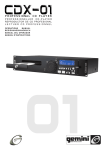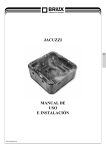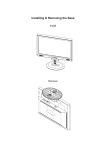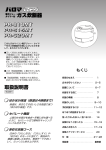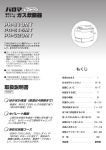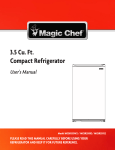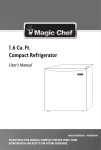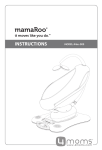Download Crosley CHEST CCF35 User's Manual
Transcript
CHEST FREEZER INSTRUCTION MANUAL Model No.: CCF35 / CCF54 / CCF73 To ensure proper use of this appliance and your safety, please read the following instructions completely before operating this appliance. CCF35_54_73 OM-ES-1 Printed in China TABLE OF CONTENTS NAMES OF THE PARTS……………………………………………………… 2 SPECIFICATIONS…………………………………………………………….. 3 IMPORTANT SAFETY INSTRUCTIONS…………………………………… 4 INSTALLATION INSTRUCTIONS BEFORE USING YOUR FREEZER…………………………………. 4 INSTALLING YOUR FREEZER ……………………………………… 4 ELECTRICAL CONNECTION………………………………………… 5 OPERATING YOUR FREEZER TEMPERATURE CONTROL………………………………………….. 5 - 6 DEFROSTING YOUR FREEZER………………………………….….. 6 THE FREEZER COMPARTMENT…………………………….……… 6 - 7 CARE AND MAINTENANCE CLEANING YOUR FREEZER………………………………………… 7 VACATION TIME………………………………………………………. 7 MOVING YOUR FREEZER…………………………………………… 7 ENERGY SAVING TIPS………………………………………………. 7 TROUBLESHOOTING GUIDE………………………………………………. 1 8-9 NAMES OF THE PARTS MODEL NO. CCF35 / CCF54 / CCF73 WARNING: Never touch the interior of the Freezer Chamber or frozen foods in the compartment with wet hands as this could result in frost bite. 2 SPECIFICATIONS – Model # CCF73 Product Description Chest Freezer Model No. CCF73 Capacity 7.3 Cu. Ft. Unit Dimensions ( inches ) Width Height Depth 34.0” 34.0” 24.0” Net Weight ( lbs) 94.8 ( lbs ) SPECIFICATIONS – Model # CCF54 Product Description Chest Freezer Model No. CCF54 Capacity 5.4 Cu. Ft. Unit Dimensions ( inches ) Width Height Depth 27.5” 34.0” 24.0” Net Weight ( lbs) 87.1 ( lbs ) SPECIFICATIONS – Model # CCF35 Product Description Chest Freezer Model No. CCF35 Capacity 3.5 Cu. Ft. Unit Dimensions ( inches ) Width Height Depth 23.6" 33.74" 21.18” Net Weight ( lbs) 62 ( lbs ) 3 IMPORTANT SAFETY INSTRUCTIONS WARNING To reduce the risk of fire, electrical shock, or injury when using your freezer, follow these basic precautions: Read all instructions before using the freezer. DANGER or WARNING: Risk of child entrapment. To avoid the possibility of child entrapment, please take the following precautions: Remove the freezer top and DO NOT remove the internal basket. Before you throw away your old freezer: Take off the top. Leave the basket in place so that children may not easily climb inside. Never allow children to operate, play with, or crawl inside the freezer. Never clean freezer parts with flammable fluids. The fumes can create a fire hazard or explosion. Do not store or use gasoline or any other flammable vapors and liquids in the vicinity of this or any other freezer. The fumes can create a fire hazard or an explosion. Never open the grill unless you are a professional. -Save these instructions- INSTALLATION INSTRUCTIONS Before Using Your Freezer Remove the exterior and interior packing. Check to be sure you have all of the following parts: 1 Storage Basket 1 Divider 1 Instruction Manual Before connecting the freezer to the power source, let it stand upright for approximately 4 hours. This will reduce the possibility of a malfunction in the cooling system from improper handling during transportation. Clean the interior surface with lukewarm water using a soft cloth. (Cleaning instruction on page 7) Installing Your Freezer This appliance is designed to be free standing only, and should not be recessed or built-in. Place your freezer on a floor that is strong enough to support the freezer when it is fully loaded. Allow 5 inches of space between the back and sides of the freezer, which allows the proper air ventilation. Adjust the feet to keep the freezer level. Locate the freezer away from direct sunlight and sources of heat (stove, heater, radiator, etc.). Direct sunlight may affect the acrylic coating and heat sources may increase electrical consumption. Ambient temperature below 50°F or above 85°F will hinder the performance of this appliance. This unit is not designed for use in a garage or any other outside installation. Avoid locating the freezer in moist areas. Plug the freezer into dedicated, properly installed-grounded wall outlet. Do not under any circumstances cut or remove the third (ground) prong from the power cord. Any questions concerning power and/or grounding should be directed toward a certified electrician or an authorized service center. This unit is not designed to be installed in an RV or used with an inverter. After plugging the appliance into a wall outlet, turn the unit on and allow the unit to cool down for 2~3 hours under before placing food in the freezer compartment. 4 Electrical Connection WARNING Improper use of the grounded plug can result in the risk of electrical shock. If the power cord is damaged, have it replaced by an authorized service center. This freezer should be properly grounded for your safety. The power cord of this freezer is equipped with a three-prong plug which mates with standard three prong wall outlets to minimize the possibility of electrical shock. Do not, under any circumstances, cut or remove the third ground prong from the power cord supplied. This freezer requires a standard 115/120 Volt A.C. ~/60Hz electrical outlet with three-prong ground. This freezer is not designed to be used with an inverter. The cord should be secured behind the freezer and not left exposed or dangling to prevent accidental injury. Never unplug the freezer by pulling the power cord. Always grip the plug firmly and pull straight out from the receptacle. Do not use an extension cord with this appliance. If the power cord is too short, have a qualified electrician or service technician install an outlet near the appliance. Use of an extension cord can negatively effect the performance of the unit. The “POWER” light (Green) indicates that the freezer is properly connected to the electrical power. The “RUN” light (Red) will not illuminate when the unit is operating below freezing. The “RUN” light will illuminate when the temperature inside the unit increases above freezing. Please be advised that the “RUN” light may come on for a period of time when the lid is opened, when new items are stored inside the unit or when the lid is forced open by irregular contents. OPERATING YOUR FREEZER Temperature Control Your freezer has one control for regulating the temperature. The temperature control is located on the lower right hand corner. The first time you turn the unit on, adjust the temperature control knob to “3” and run for at least 2 hours before putting frozen foods inside. This will ensure the cabinet is thoroughly chilled before food is put in. The range of the FREEZER temperature control is from position "1" the warmest to "5" the coldest. Adjust the temperature control to the setting that best suits your needs. The setting of “3” should be appropriate for home or office freezer use. 5 NOTE; If the unit is unplugged, loses power; you must wait 3 to 5 minutes before restarting the unit. If you attempt to restart before this time delay, the freezer will not start. Large amounts of food will lower the cooling efficiency of the appliance. If you choose to change the thermostat setting, adjust thermostat control by one numerical increment at a time. Allow several hours for temperature to stabilize between adjustments. Defrosting Your Freezer When? For the most efficient operation and minimum energy consumption, defrost the freezer when the frost on the freezer walls is excessive or ¼ to ½ inch thick. Choose a time when the stock of frozen food is low. CAUTION Do not use boiling water because it may damage the plastic parts. In addition, never use a sharp or metallic instrument to remove frost as it may damage the cooling coils and will void the warranty. Remove the frozen food from the freezer and place it in a cooler to protect the food. Unplug the freezer. The Power Supply light should be off (green light out). During defrosting, the ice melts into the cabinet. Remove the drain plug on the inside floor of the freezer by pulling straight out. Place a shallow pan outside drain outlet. The defrost water will drain out. Check the pan occasionally so the water does not overflow. Clean the interior of the freezer. Replace the plug on the inside floor. Adjust the temperature control knob to “3”. Allow the cabinet to cool for one hour. Return food to the freezer. HELPFUL HINT: Defrosting usually takes a few hours. Leaving the door open will help speed the process. Also, pouring warm water (not boiling) on the ice/frost will help speed melting. WARNING Scraping ice from the freezer compartment can damage the unit. The Freezer Compartment This compartment is designed for the long-term storage of frozen food. Storage time period is up to three months. The storage life of frozen foods varies and the recommended storage time should not be exceeded. The instructions regarding the care of frozen foods should be followed when defrosting the freezer. Pre-packed commercially frozen food should be stored in accordance with the frozen foods manufacturers’ instructions for a three star frozen food storage compartment or home freezer. Place frozen food into the freezer as quickly as possible after purchase. If there are instructions on the packet, carefully follow these instructions regarding storage times. The freezer lid is susceptible to breaking due to excessive ice build up. Be sure to defrost when the ice reaches ¼ to ½ inch thick. A storage basket is provided for the organization of odd-shaped items. To reach other packages in the freezer, just slide the basket to one side, or lift it out. 6 CARE AND MAINTENANCE Cleaning Your Freezer Upon installation of your new appliance, it is recommended that it be cleaned thoroughly. Unplug the freezer, remove the food and storage basket. Wash the inside with a damp warm cloth soaked in lukewarm water and baking soda solution. The solution should be about 2 tablespoons of baking soda to a quart of water. Wash the storage basket with a mild detergent solution. Be sure to keep the door gasket (seal) clean to keep the unit running efficiently. The outside of the freezer should be cleaned with mild detergent and warm water. Dry the interior and exterior with a soft cloth. The condenser coils should be vacuumed when they are dusty or dirty. It is recommended that the unit be cleaned each time it is defrosted to help keep the unit odor free and running efficiently. Vacation Time Remove all the food. Unplug the freezer. Clean the freezer. Leave the lid open slightly to avoid possible formation of condensation, mold, or odors. Use extreme caution in the case of children. The unit should not be accessible to child’s play. Short vacations: Leave the freezer operating during vacations of less than three weeks. Long vacations: If the appliance will not be used for several months, remove all food and unplug the power cord. Clean and dry the interior thoroughly. To prevent odor and mold growth, leave the door open slightly: blocking it open if necessary or have the door removed. Moving Your Freezer Unplug the freezer. Remove all the food. Securely tape down all loose items inside your freezer. Remove the rollers to prevent damage. Tape the doors shut. Be sure the freezer stays in the upright position during transportation. Energy Saving Tips The freezer should be located in the coolest area of the room, away from heat producing appliances or heating ducts, and out of the direct sunlight. Let hot foods cool to room temperature before placing in the freezer. Overloading the freezer forces the compressor to run longer. Foods that freeze too slowly may lose quality, or spoil. Be sure to wrap foods properly, and wipe containers dry before placing them in the freezer. This cuts down on frost build-up inside the freezer. Freezer storage bin should not be lined with aluminum foil, wax paper, or paper toweling. Liners interfere with cold air circulation, making the freezer less efficient. Organize and label food to reduce door openings and extended searches. Remove as many items as needed at one time, and close the door as soon as possible. 7 TROUBLESHOOTING GUIDE You can solve many common freezer problems easily, saving you the cost of a possible service call. Try the suggestions below to see if you can solve the problem before calling for service. PROBLEM Freezer does not operate. POSSIBLE CAUSE Not plugged in. The circuit breaker tripped or a blown fuse. The room temperature is hotter than normal. A large amount of food has been added to the freezer. The door is opened too often. The door is not closed completely. The temperature control is not set correctly. The door gasket does not seal properly. The freezer does not have the correct clearances. The freezer has recently been disconnected for a period of time. 4 hours are required for the freezer to cool down completely. Temperature control is set too warm. Turn the control to a cooler setting and allow several hours for the temperature to stabilize. Door is kept open too long or is opened too frequently. Warm air enters the freezer every time the door is opened. Open the door less often. The door is not closed completely. The door gasket does not seal properly. A large amount of warm or hot food might have been stored recently. Wait until the freezer has had a chance to reach its selected temperature. The freezer has recently been disconnected for a period of time. 4 hours are required for the freezer to cool down completely. Temperature control is set too cold. Turn the control to a warmer setting and allow several hours for the temperature to stabilize. The exterior freezer walls can be as much as 30F warmer than room temperature. This is normal while the compressor works to transfer heat from inside the freezer cabinet. Metal parts undergo expansion and contraction, as in hot water pipes. This is normal. Sound will level off or disappear as freezer continues to run. Refrigerant (used to cool freezer) is circulating throughout the system. This is normal. Check to assure that the freezer is on a level surface. Floor is uneven or weak. Freezer rocks on the floor when it is moved slightly. Be sure floor can adequately support freezer. Level the freezer by putting wood or metal shims under part of the Compressor turns on and off frequently. Temperature inside the freezer is too warm. Temperature inside the freezer is too cold. Temperature of external freezer surface is warm. Popping or cracking sound when compressor comes on. Bubbling or gurgling sound, like water boiling. Vibrations. 8 freezer. The freezer is touching the wall. Re-level the freezer and move it from the wall. See “Installation Instructions”. Weather is hot and humid, which increases internal rate of frost build-up. This is normal. Door is slightly open. Door is kept open too long, or is opened too frequently. Open the door less often. The door is not sealed properly. Door is slightly open, causing cold air from inside the freezer to meet warm moist air from outside. The freezer is not on a level surface. The gasket is dirty. The storage basket is out of position. Moisture forms on inside freezer walls. Moisture forms on outside of freezer. The door will not close properly. 9 Chest Freezer Warranty Teamex Corporation warrants this product to be free from defects in materials and workmanship for a period of one year from the date of the original purchase or delivery. Teamex warrants 1 year labor and parts. Any parts that are determined to be defective will be replaced or repaired, at its sole discretion, by Teamex at no charge as long as it has been determined that the unit was operated in accordance with the instructions attached or furnished with the product. If the unit proves to be defective, your first course of action should be to follow the retailer’s return policy. This warranty covers units only in the continental United States and does not cover the following: Damage from improper voltage or installation Damage in shipping Defects other than manufacturing defects Any installation expenses that may be incurred Glass, trim or light bulb Labor or repairs after the initial 12-month period Damage from abuse, misuse, accident, alteration or lack of proper care or maintenance Improper or incorrectly performed maintenance or repairs Use of parts not recommended by Teamex Corporation Damage due to acts of God. This limited warranty is given in lieu of all other warranties expressed or implied. This warranty does not cover incidental or consequential damages. Some States do not allow the exclusion or limitation of incidental or consequential damages, so the above limitation may not apply to you. This warranty provides you with specific legal rights and you may have other rights which vary from state to state. Consult the written materials accompanying your product for the safe and proper operation. This warranty may not be assigned. For warranty service, contact Teamex Corporation 725 Dell Rd Carlstadt NJ 07072 Tel.: 1-888-446-4869 E-mail: [email protected] When service is required, have on hand the Model and Serial numbers found on the rating label on the back of the unit, as well as proof of purchase such as a sales or gift receipt. 10 CONGELADOR MANUAL DE INSTRUCCIONES Modelo Nº : CCF35 / CCF54 / CCF73 Para asegurar el uso apropiado de este aparato y su seguridad, leyó por favor las instrucciones siguientes completamente antes de operar este aparato. CCF35_54_73 OM-ES-1 Printed in China 11 INDICE DE MATERIAS LOS NOMBRES DE LAS PARTES.............................................................. 2 ESPECIFICACIONES................................................................................... 3 LAS INSTRUCCIONES IMPORTANTES DE LA SEGURIDAD.................... 4 INSTRUCCIONES DE INSTALACIÓN ANTES DE UTILIZAR SU CONGELADOR........................................ 4 INSTALACIÓN DE SU CONGELADOR …………………...........….... 4-5 CONEXIÓN ELÉCTRICA……………….……………………………..... 5 OPERAR SU CONGELADOR CONTROL DE TEMPERATURA …………………………………….... 6 PARA DESCONGELAR SU CONGELADOR……………................ 6 - 7 CAJA DEL CONGELADOR…….......................……………….......... 7 CUIDE Y LA CONSERVACION PARA LIMPIAR SU CONGELADOR…………………….................. 7 EN LAS VACACIONES ..……………………………………..………… 7 - 8 PARA CAMBIAR DE LUGAR SU CONGELADOR…….......………… 8 RECOMENDACIONES PARA AHORRAR ENERGÍA………………. 8 GUÍA DE RESOLUCIÓN DE PROBLEMAS………………………………….. 9 - 10 12 LOS NOMBRES DE LAS PARTES MODELO Nº . CCF35 / CCF54 / CCF73 ADVERTENCIA: Nunca toque el interior de la Cámara del Congelador ni alimentos congelados en el compartimiento con manos mojadas como esto podría tener como resultado cubre de escarcha la mordedura. 13 ESPECIFICACIONES - MODELO Nº CCF73 Descripción de producto Congelador de pecho Modelo No. CCF73 Capacidad 7.3 Cu. Ft. Dimensiones (pulgadas) de unidad Anchura Altura Profundidad 34.0” 34.0” 24.0” Peso neto 94.8 ( lbs ) ESPECIFICACIONES - MODELO Nº CCF54 Descripción de producto Congelador de pecho Modelo No. CCF54 Capacidad 5.4 Cu. Ft. Dimensiones (pulgadas) de unidad Anchura Altura Profundidad 27.5” 34.0” 24.0” Peso neto 87.1 ( lbs ) ESPECIFICACIONES - MODELO Nº CCF35 Descripción de producto Congelador de pecho Modelo No. CCF35 Capacidad 3.5 Cu. Ft. Dimensiones (pulgadas) de unidad Anchura Altura Profundidad 23.6” 33.74” 21.18” Peso neto 62 ( lbs ) 14 LAS INSTRUCCIONES IMPORTANTES DE LA SEGURIDAD ADVERTENCIA Para reducir el riesgo de incendios, golpes de corriente o lesiones cuando utilice su Congelador, sírvase tener en cuenta las siguientes recomendaciones básicas: Lea atentamente todas las instrucciones antes de usar el Congelador. El PELIGRO o ADVIRTIENDO: Riesgo de que los niños queden atrapados. Para evitar este riesgo, sírvase observar las siguientes recomendaciones: Retire la tapa del Congelador y NO retire los cestas internos. Antes de deshacerse de su viejo Congelador: retire la tapa y deje los cestas en su lugar para que los niños no puedan introducirse en el interior. No deje que los niños usen el Congelador, jueguen con él o se introduzcan en el interior. No limpie las partes del Congelador con productos inflamables. Los vapores pueden originar un incendio o explosión. No almacene ni use gasolina ni ningún otro gas o líquido inflamable cuando se encuentre cerca de este Congelador u otro. Los vapores pueden originar un incendio o explosión. Nunca abra la parrilla a menos que usted sea un profesional. -Excepto estas instrucciones- INSTRUCCIONES DE INSTALACIÓN ANTES DE UTILIZAR SU CONGELADOR Retire el material de embalaje del exterior e interior. Verifique que estén los siguientes elementos: 1 canasto de almacenamiento 1 divisor 1 manual de instrucciones Antes de conectar el Congelador a la fuente de alimentación, déjelo en posición vertical durante 4 horas aproximadamente. De esta forma, se reducirá la posibilidad de mal funcionamiento del sistema de refrigeración debido a manipulación incorrecta durante el traslado. Limpie la superficie interior con agua tibia y paño suave. (Limpiando la instrucción en la página 7) INSTALACIÓN DE SU CONGELADOR Este electrodoméstico está diseñado para funcionar apoyado sobre el piso y no debe empotrarse ni embutirse en la pared. Coloque el Congelador sobre un piso que sea lo suficientemente resistente como para sostener el peso del electrodoméstico cuando esté cargado. Deje el Congelador separado 5 pulgadas de las paredes atrás y de los costados para que haya buena circulación de aire. Ajuste los pies para mantener el congelador llano. Ubique el Congelador fuera de la luz directa del sol y otras fuentes de calor (horno, calentador, radiador, etc.). La luz directa del sol puede afectar la cubierta de acrílico y las fuentes de calor pueden aumentar el consumo eléctrico. La temperatura ambiente debajo de 50°F o sobre 85°F obstaculizará el funcionamiento de esta aplicación. Esta unidad no se diseña para el uso en un garage o ninguna otra instalación exterior. 15 No coloque el Congelador en ambientes húmedos. Enchufe el Congelador en un toma corriente con la debida descarga a tierra utilizado exclusivamente para este aparato. No corte ni retire la tercera pata (descarga a tierra) del enchufe bajo ninguna circunstancia. Cualquier duda relacionada con la red de electricidad y/o la descarga a tierra debe resolverse con un electricista certificado o un centro de servicios autorizado. Esta unidad no se diseña para ser instalada en un RV o para ser utilizada con un inversor. Después de enchufar en el tomacorriente de pared, prende la unidad y permite la unidad enfríe durante 2 ó 3 horas antes de colocar alimentos en el interior. CONEXIÓN ELÉCTRICA ADVERTENCIA El uso indebido de la descarga a tierra puede causar golpes de corriente. Si el cable de alimentación está dañado, hágalo reemplazar con un service autorizado. El Congelador debe estar adecuadamente conectado a tierra para su seguridad. El cable de electricidad de este electrodoméstico cuenta con un enchufe de tres patas apto para los tomacorrientes de pared con tres patas para minimizar las posibilidades de golpes de corriente. No corte ni retire la tercera pata de descarga a tierra del enchufe bajo ninguna circunstancia. Este equipo debe conectarse a un toma corriente de tres patas con descarga a tierra instalado en una red estándar de electricidad con corriente 115/120 Volt A.C. ~/60Hz. Este congelador no se diseña para ser utilizado con un inversor. El cable debe mantenerse recogido detrás del Congelador; no debe dejarse a la vista ni colgando para prevenir accidentes. No desenchufar tirando del cable. Tome el enchufe con firmeza y tire en dirección opuesta al receptáculo. No utilice prolongaciones para conectar este aparato. Si el cable es muy corto, llame a un electricista o técnico calificado para que instale un toma corriente cerca del equipo. El uso de cables de prolongación puede perjudicar el funcionamiento de la unidad. La luz “POWER” indica (Verde) que el Congelador está correctamente conectado a la red de electricidad. La luz “RUN” (Rojo) no iluminará cuando la unidad está funcionando debajo de congelar. La luz “RUN” temperatura iluminará cuando la temperatura dentro de la unidad aumenta por encima de cero grados. Aconséjese por favor que la luz “RUN” puede adelantarse por un período del tiempo en que se abre la tapa, en que los nuevos artículos se almacenan dentro de la unidad o en que la tapa es forzada ábrase por el contenido irregular. 16 OPERAR SU CONGELADOR CONTROL DE TEMPERATURA La unidad tiene un control para regular la temperatura. El control de temperatura está ubicado en el extremo inferior derecho. La primera vez que usted gira la unidad, ajuste la perilla del control de la temperatura a "3" y funcione por por lo menos 2 horas antes de poner los alimentos congelados adentro. De esta forma, el gabinete estará suficientemente refrigerado antes de colocar los alimentos. Las temperaturas del control varían desde la posición "1", la más baja, hasta "5", la más fría. Elija la temperatura más conveniente para sus necesidades y fíjela en el control. La posición “3“ debería ser la indicada para el uso en el hogar o en la oficina. NOTA; Si se desenchufa la unidad, pierde energía; usted debe esperar 3 a 5 minutos antes de recomenzar la unidad. Si intenta volver a ponerla en funcionamiento antes de transcurrido ese período, el Congelador no funcionará. Las grandes cantidades de alimentos disminuyen la capacidad de enfriamiento del aparato. Si decide modificar el valor fijado en el termostato, ajústelo modificando de a un número por vez. Cada vez que realiza un ajuste, deje pasar varias horas para que se estabilice la temperatura. PARA DESCONGELAR SU CONGELADOR ¿Cuándo? Para un funcionamiento más eficiente y un consumo mínimo de energía, descongele el Congelador cuando la acumulación de escarcha sobre las paredes del Congelador sea excesiva o tenga un espesor de más de ¼ a ½ de pulgada. Elija un momento en que no haya gran cantidad de alimentos congelados. CUIDADO No utilice agua hirviendo porque puede dañar las partes de plástico. Además, no utilice elementos filosos ni metálicos para retirar el hielo ya que pueden dañar las bobinas de refrigeración y anular la validez de la garantía. Retire los alimentos congelados del Congelador y colóquelos en un refrigerador para conservarlos. Desenchufe el Congelador. La luz Power Supply debe apagarse (luz verde apagada). Durante el descongelado el hielo se derrite dentro del gabinete. Retire el tapón del drenaje en el piso interior del Congelador tirando hacia fuera. Coloque una bandeja plana a la salida del drenaje. El agua del deshielo drenará hacia el exterior. Controle la bandeja cada tanto para que el agua no desborde. Limpie el interior del Congelador. Vuelva a colocar el tapón en el piso interior. Ajuste la perilla del control de la temperatura a "3". Deje que el gabinete se refrigere durante una hora. 17 Vuelva a colocar los alimentos en el Congelador. INSINUACIÓN ÚTIL El proceso de descongelado en general demora algunas horas. Dejar la puerta abierta ayuda a acelerar el proceso. Además, verter agua caliente (no hirviendo) sobre el hielo acelera el proceso de fusión. ADVERTENCIA Despegar el hielo adherido raspando el compartimiento del Congelador puede dañar la unidad. CAJA DEL CONGELADOR Este compartimiento está diseñado para el almacenamiento de alimentos congelados durante períodos prolongados. El período máximo de almacenamiento es de tres meses. El tiempo máximo de almacenamiento depende del alimento que se congele y nunca se debe exceder el tiempo recomendado. Se deben observar todas las recomendaciones con respecto al cuidado de los alimentos congelados cuando se procede a descongelar el Congelador. Los alimentos pre-envasados congelados se deben guardar siguiendo las indicaciones del fabricante para un Congelador de tres estrellas o Congelador doméstico. Coloque los alimentos congelados en el Congelador lo antes posible después de la compra. Si el paquete trae instrucciones, siga las recomendaciones sobre los tiempos de guardado. La puerta del Congelador se puede romper cuando se acumula excesiva cantidad de hielo. Recuerde descongelar la unidad cuando el hielo tenga un espesor de ¼ a ½ pulgada. El Congelador viene con un canasto para poder organizar los trozos con formas variadas. Para sacar los paquetes del Congelador, deslice el canasto hacia un lado o levántelo. CUIDE Y LA CONSERVACION PARA LIMPIAR SU CONGELADOR Una vez finalizada la instalación, se recomienda una limpieza completa de la unidad. Desenchufe la unidad y retire los alimentos y el canasto de almacenamiento. Limpie el interior con un paño humedecido en una solución de agua tibia y bicarbonato de soda. La solución se prepara con aproximadamente 2 cucharadas de bicarbonato de soda y un cuarto de agua. Lave el canasto de almacenamiento con una solución preparada con detergente suave. Recuerde mantener limpia la junta de la puerta (burlete) para que la unidad funcione correctamente. La parte exterior del Congelador se debe limpiar con una solución de agua tibia y detergente suave. Seque el interior y exterior con paño suave. Las bobinas del condensador se deben limpiar con la aspiradora cuando se acumule polvo o suciedad. Se recomienda limpiar la unidad cada vez que se descongela para mantenerla libre de olores y en perfecto funcionamiento. EN LAS VACACIONES Quite todo el alimento. Quite el congelador. Limpie el congelador. Deje la puerta apenas abierta para evitar la posible formación de condensación, moho u olores. Extreme los cuidados cuando haya niños. La unidad no debe ubicarse donde los niños puedan jugar con ella. 18 Vacaciones cortas: Deje el Congelador en funcionamiento durante los períodos de vacaciones que no superen las tres semanas. Vacaciones largas: Si el electrodoméstico no se usa durante varios meses, retire todos los alimentos y desconecte de la red de electricidad. Limpie y seque cuidadosamente el interior. Para evitar la formación de olores y humedad, deje la puerta apenas abierta: si es necesario, trábela para que se mantenga abierta o retire la puerta. PARA CAMBIAR DE LUGAR SU CONGELADOR Quite el congelador. Quite todo el alimento. Asegure con cinta adhesiva los elementos sueltos en el interior del Congelador. Retire los rodillos para evitar daños. Asegure la puerta con cinta adhesiva. Verifique que el Congelador se mantenga en posición vertical durante el traslado. RECOMENDACIONES PARA AHORRAR ENERGÍA El Congelador se debe ubicar en el lugar más fresco de la habitación, alejado de las fuentes de calor y de caños de calefacción, y protegido de la luz del sol directa. Deje que los alimentos calientes se enfríen hasta llegar a la temperatura ambiente antes de colocarlos en el Congelador. Si se coloca una cantidad excesiva de alimentos en el Congelador, se fuerza el compresor a trabajar durante más tiempo. Los alimentos que tardan mucho en congelarse pueden perder calidad o echarse a perder. Asegúrese de envolver los alimentos adecuadamente y seque los envases antes de ubicarlos en el Congelador. Esto ayuda a reducir la formación de escarcha en el interior. La cavidad de almacenamiento del Congelador no debe recubrirse con papel de aluminio, ni con papel encerado o papel absorbente. Los recubrimientos interfieren con la circulación de aire frío perjudicando el funcionamiento del Congelador. Organice y etiquete los alimentos para reducir la cantidad de veces que abre la puerta y las demoras de la búsqueda. Retire todos los elementos que necesita de una sola vez y cierre la puerta lo antes posible. 19 GUÍA DE RESOLUCIÓN DE PROBLEMAS Usted puede resolver muchos de los inconvenientes comunes que se producen con el Congelador y ahorrarse el costo de llamar al servicio de mantenimiento. Intente las sugerencias a continuación para ver si puede resolver los problemas antes de llamar al service. PROBLEMA El Congelador no funciona. El compresor se prende y se apaga con frecuencia. La temperatura del interior del Congelador es muy elevada. La temperatura del interior del Congelador es muy baja. La temperatura del exterior del Congelador es elevada. Ruidos de explosiones o rajaduras cuando el CAUSA POSIBLE No está enchufado. Se activó el corta corriente o se quemó un fusible. La temperatura ambiente es más elevada que lo normal. Se ha colocado gran cantidad de alimentos en el Congelador. La puerta se abre con mucha frecuencia. La puerta no está completamente cerrada. La temperatura fijada en el control no es la correcta. La junta de la puerta no ajusta lo necesario. El Congelador no está lo suficientemente alejado de las paredes que lo rodean. El Congelador estuvo últimamente desconectado durante un período de tiempo. Se requieren 4 horas para que el Congelador se enfríe completamente. El control de temperatura está fijado a una temperatura muy elevada. Fije el control a una temperatura más baja y deje que la temperatura se estabilice durante varias horas. La puerta estuvo mucho tiempo abierta o se abrió con mucha frecuencia. Cada vez que se abre el Congelador entra aire caliente. Abra la puerta con menos frecuencia. La puerta no está completamente cerrada. La junta de la puerta no ajusta lo suficiente. Es posible que recientemente se haya guardado una gran cantidad de alimentos tibios o calientes. Espere hasta que el Congelador haya tenido la oportunidad de alcanzar la temperatura fijada. El Congelador estuvo últimamente desconectado durante un período de tiempo. Se requieren 4 horas para que el Congelador se enfríe completamente. El control de temperatura está fijado a una temperatura muy baja. Fije el control a una temperatura más elevada y deje que la temperatura se estabilice durante varias horas. Las paredes externas pueden llegar a tener una temperatura 30ºF por encima de la temperatura ambiente. Esta situación es normal mientras el compresor trabaja para sacar el calor del interior del gabinete. Las partes metálicas se expanden y contraen 20 compresor empieza a funcionar. Ruidos burbujeantes parecidos al del agua hirviendo. Vibraciones. Se forma humedad en las paredes interiores del Congelador Se forma humedad en las paredes externas del Congelador La puerta no cierra convenientemente. como ocurre en las cañerías de agua caliente. Es normal. Los ruidos se normalizarán o desaparecerán a medida que el Congelador siga funcionando. El refrigerante (utilizado para enfriar el Congelador) está circulando por el sistema. Es normal. Verifique que el Congelador esté sobre una superficie nivelada. El piso está desparejo o no es fuerte. El Congelador se balancea sobre el piso apenas se lo toca. Verifique que el piso soporta adecuadamente el Congelador. Nivele el electrodoméstico poniendo cuñas de metal o madera debajo del Congelador El Congelador está tocando la pared. Vuelva a nivelar y retirar de la pared. Lea las "Instrucciones de instalación". El tiempo está caluroso y húmedo, lo que ocasiona la mayor acumulación de escarcha en el interior. Es normal. La puerta está apenas abierta. La puerta está mucho tiempo abierta o se abre con mucha frecuencia. Abra la puerta con menos frecuencia. La junta de la puerta no ajusta lo necesario. La puerta está apenas abierta y el aire frío del interior se combina con el aire tibio del exterior. El Congelador no está en una superficie nivelada. La junta está sucia. El canasto de almacenamiento está mal colocado. 21 Garantía Congelador Teamex Corporation, garantiza que este producto está libre de defectos en materiales y mano de obra durante un periodo de un año desde la fecha de compra original o de entrega. Teamex garantiza de 1 año mano de obra y partes. Cualquier pieza que se encuentre defectuosa será reemplazada o reparada, a su sola discreción, por Teamex sin costo siempre que se haya determinado que la unidad ha sido operada siguiendo las instrucciones que vienen y se entregan con el producto. Si se demuestra que la unidad está defectuosa, su primer curso de acción debe ser seguir la política de devolución de la tienda. Esta garantía cubre sólo unidades dentro de los Estados Unidos continentales y no cubre lo siguiente: Daño por voltaje o instalación inadecuada Daño en el transporte Defectos que no son de fábrica Cualquier gasto por instalación Bombilla de vidrio, recortadas o débiles Mano de obra o reparaciones hechas después del periodo inicial de 12 meses Daños por abuso, mal uso, accidente, alteración o falta de cuidado o mantenimiento adecuados Mantenimiento o reparación inadecuados o realizados incorrectamente Uso de piezas no recomendadas por Teamex Corporation. Daños debido a desastres naturales. Esta garantía limitada substituye a todas las demás garantías expresas o implícitas. Esta garantía no cubre daños accidentales o resultantes. Algunos estados no permiten la exclusión o limitación de daños accidentales o resultantes, de modo que la limitación mencionadas más arriba podrían no aplicarse a usted. Esta garantía le provee derechos legales específicos y usted podría tener otros derechos que varían de estado a estado. Consulte los materiales escritos que acompañan su producto para un funcionamiento seguro y adecuado. Esta garantía no puede ser cedida. Para servicio de garantía, contáctese con Teamex Corporation 725 Dell Rd Carlstadt NJ 07072 Tel.: 1-888-446-4869 E-mail: [email protected] Cuando necesite recibir servicio, tenga a mano el Modelo y el Número de Serie que están en la etiqueta de clasificación en la parte trasera de la unidad, así como el comprobante de pago, tal como un recibo de compra o de regalo. 22























